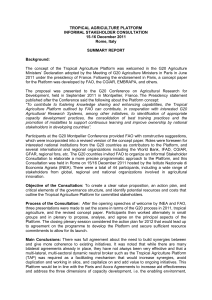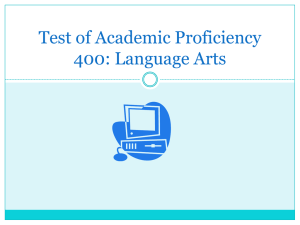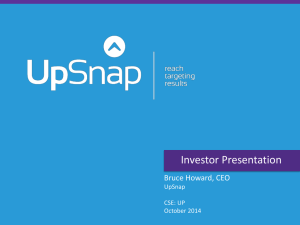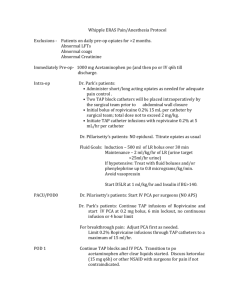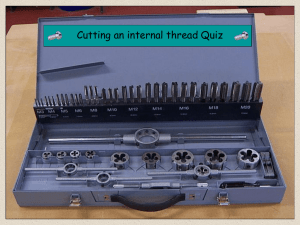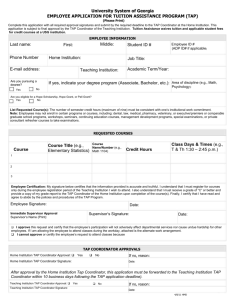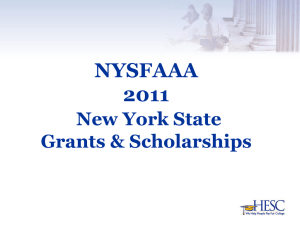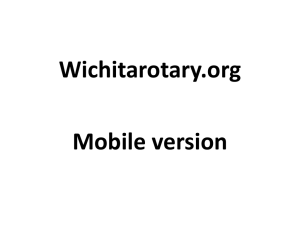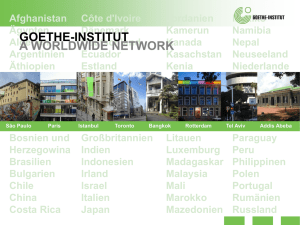progress report GCARD 2 Pre-Conference Meeting Punta del Este
advertisement
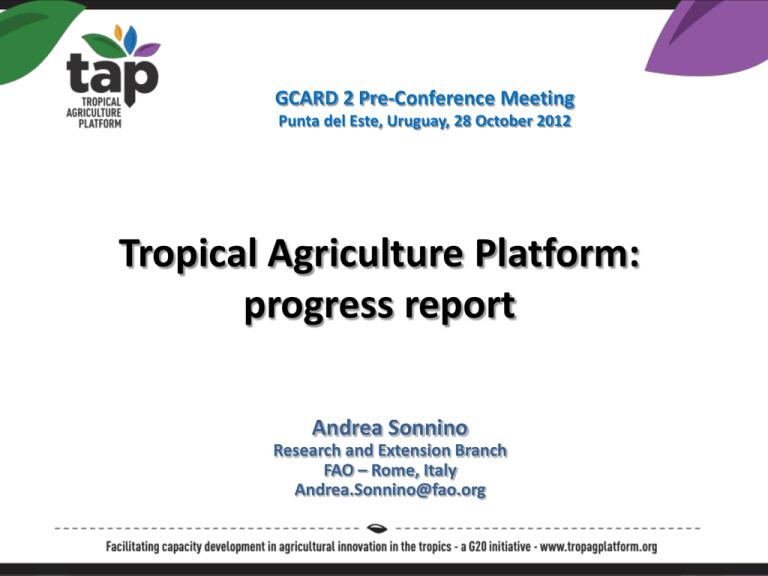
GCARD 2 Pre-Conference Meeting Punta del Este, Uruguay, 28 October 2012 Tropical Agriculture Platform: progress report Andrea Sonnino Research and Extension Branch FAO – Rome, Italy Andrea.Sonnino@fao.org Tropical Agriculture Platform: progress report • Summary of the TAP concept • The progress made The Problems at Stake Numerous interventions addressing gaps in capacity and knowledge in agricultural innovation in tropical areas have: • Insufficient alignment with country/regional policies & needs • Insufficient coordination and synergy between them • Small-scale activities with high transaction costs and limited impact • Inadequate analysis of interdisciplinary needs and the demands of agricultural markets. The TAP objective The TAP Approach Multilateral, multi-sectoral facilitation mechanism Convening stakeholders at global and national level Enabling actors to contribute through partnerships Creating more coherent actions with greater impact Aligning with national, regional and global policy frameworks FAO acting as a global facilitator and convenor The TAP Target Groups Target Groups (directly affected): • policymakers and institutions in agricultural innovation (research, extension, education etc), • the private sector and civil society active in innovation systems • relevant development agencies, fora etc. The TAP Outputs Assessment of current Capacities and Needs Strategic Action Plan Enhanced Policy Dialogue 7 Common framework and guidelines for capacity development Effective Capacity Development Partnerships Enhanced knowledge exchange in support of capacity development The difference TAP will make • Partnerships and shared visions fostered to promote: – capacity development interventions more coherent and aligned with national plans and demands – national leadership and ownership acknowledged • Capacity development solutions developed at scale and with lower transaction costs • Knowledge and experiences shared between broad constituencies of stakeholders Tropical Agriculture Platform: progress report • Summary of the TAP concept • The progress made TAP genesis • Concept approved by G20 Agriculture Ministers Declaration, Paris, Jun 2011 • Discussed at G20 Conference on Ag. Research for Development, Montpellier, Sep 2011 • Developed by Informal Stakeholder Consultation, Rome, Dec 2011 • Endorsed by G20 Agriculture & Development Working Groups, Mar-May 2012, and by G20 Leaders’ Summit, Mexico, Jun 2012 • Recognized by the G-8 Summit, USA, May 2012 • Launch at G20 MACS, Mexico, Sep 201 The initial steps • Constituency formed – – – – 63 invited 29 partners More announced Others support • Draft operational framework and workplan TAP Partners as of 28 October 2012 Global Fora Regional Fora International Organizations Others GCHERA AARINENA IFAD AGRA GFRAS APAARI World Bank Agrinatura GFAR CAACARI IICA ITPGRFA YPARD FARA CTA TAP Partners as of 28 October 2012 National Research Institutions International Research Institutes AGREENIUM France IAARD Indonesia INTA Argentina CABI UK ICIMOD Nepal ARC South Africa INIA Spain JIRCAS Japan CATIE Costa Rica ICIPE Kenya CAAS and CATAS China INIFAP Mexico Wageningen University Holland ICBA UAE Initial steps (ctd) • Initial funds raised – – – – France 55,000 Euros [FAO 300,000 USD] [SSC Fund 75,000 USD] [China (SSC) 200,000 USD] • Outreach – TAP Web site – Brochure Next steps • Operational framework finalized at GCARDII, Uruguay, Oct 2012 • Continued resource mobilization • Inception phase (component 1 + institutional arrangements) From November 2012 to March/April 2013 • Implementation (components 2 to 4) – From April/May 2013 on Major challenges • Focus • Alignment with other initiatives • Commitment and engagement of the partners • Value for partners Thank you for your attention

